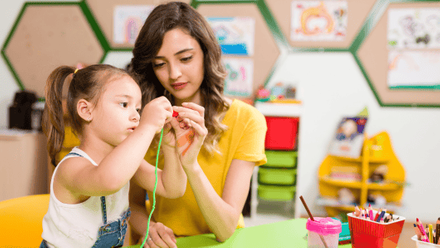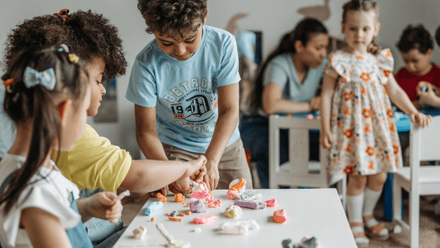How do I learn?
When planning activities for your key children, what do you think about first? Their interests? Their next steps and goals? The things they have enjoyed doing recently and ways to extend their opportunities? How they enjoy learning? Probably all of them!
But, when it comes to our own development, we rarely consider all these aspects. Focusing our own interests and shaping our learning to suit us as adult is less common than you might think, and certainly less common than for the children in our care.
In this learning workout we will focus on one of these key questions: How do we learn? The member resources you come across as part of your Institute membership are all aimed to provide bite-size and accessible Continuing Professional Development (CPD) opportunities. CPD can come in many different forms, from podcasts to interactive webinars, through to jotting down written notes or building models that reflect our understanding of a wider pedagogical concept.
We are going to think about different ways we can interact with CPD and how their various styles can aid our development. We’ll also take an opportunity to reflect on your current practice and how to further develop skills for growth in your career.
Important: learning styles are no longer an established theory of practice within educational psychology and, therefore, not something we are endorsing within this resource. Instead, we want to take the opportunity to think about different methods of learning and how to maximise variety for increased engagement in continuing professional development.
Different ways we learn
There are many different ways to learn and they all have their individual quirks. Some content is better understood when we draw pictures or label diagrams, whilst learning a song is usually done by listening to the audio too. Regardless of what we are choosing to learn, we don’t just use one format. A combination of methods and routines create our unique formula for optimum learning – a special mixture that provides the best recipe for learning just for us.
Whilst it is helpful to identify which ways suit us best, it is important to not ‘box ourselves in’ to one style of learning. Labelling our learning can lead to a lack of confidence in our learning elsewhere and, just as we never stop learning, our learning never stops changing! Let’s take a look at some of the most recognized ways to learn and their characteristics.
Learning through what we see
What does it mean?
A lot of us like to watch documentaries and learn new things about the world around us by viewing it. It might involve watching a short video explaining a theory, or developing pictures and charts that explain a process. It’s useful for thinking about complex images where lots of things are working together or demonstrations of methods in action, like this one here.
Advantages:
- it is helpful for imagining how things look when thinking about complicated designs
- it allows us to process information at a faster rate and associate information with key images
- imagery can be useful to connect ideas and see the relationships between areas of learning in a visual way.
Disadvantages:
- visuals, such as infographics and mindmaps, might take ‘note forms’ that do not always include the most specific information needed
- we can sometimes get carried away with making things look creative rather than absorbing the details
- it can be easier to ‘tune out’ of videos if we are passively watching them alone without other engagement in the material, like making notes alongside.
It may look like:
- colour-coding
- using sticky notes to disperse ideas or categorise them
- creating infographics using sites like Canva or Miro to facilitate online sharing and collaborative work.
Learning through sound
What does it mean?
This means we are listening to our learning. It might involve media like podcasts or radio but also might mean that we listen to a teacher talking didactically at us, rather than engaging in ‘doing’ ourselves. This is often about a transfer of knowledge and involves listening intently to what is being said. On the other hand, we can also learn through talking to others! When we explain concepts to others and teach others, we consolidate the knowledge ourselves and it is proven to be extremely valuable for our own development of understanding as well.
Advantages:
- it gives the option for learners to multitask by taking precise notes alongside listening
- it allows greater time for more in-depth explanations, using examples that can be reworded to allow them to be understood by everyone
- it is accessible to learners with a physical disability that creates additional barriers for visual-based methods.
Disadvantages:
- words disappear once they are spoken! It can be difficult to retain information if there is not an additional aspect of learning, such as taking notes or drawing pictures to go alongside
- for some learners, staying still and being ‘spoken to’ might pose additional challenges for attention and ability to engage with the material so it’s important that auditory learning is used alongside other methods
- it is difficult to work with others through this method as your main focus must be on listening.
It may look like:
- listening to radio or podcasts that impart information or engage in discussion about a topic to offer wider opinions and extend understanding
- creating songs and raps to memorise essential information, like this one.
Reading/writing
What does it mean?
Reading and writing is a traditional form of learning that revolves around practices of reading text-based sources and consolidating the knowledge through written text. It might take place independently or collaboratively with others.
Advantages:
- it is easy to keep learning organised and neat through written work, allowing us to revisit in-depth concepts easily
- reading from a wide range of sources gives us a rich understanding of the content and allows us the time to dissect its meanings
- using our own words allows us to put concepts into ways that make sense to us, increasing our ability to retain the knowledge and think about our learning as a personal journey.
Disadvantages:
- writing things up can take a long time to do and it can be difficult to find key words and sources again if we have lots of notes
- reading and writing activities are often very independent so this makes it difficult to collaborate with others and share ideas.
This might look like:
- reading comprehension tasks, note taking
- using flashcards or using digital methods like quizlet to record written information.
Learning by doing
What does it mean?
Kinaesthetic learning is all about the doing! Learning by doing is similar to learning through play, using our hands and actions to get ‘stuck in’ and learn through the performances we make.
Advantages:
- engaging in a stimulating environment can be helpful for motivation and attaching learning to specific events or actions
- hands-on experiences allow for experimentation which is great if you are learning about theories and testing their outcomes!
- learning by doing is accessible to lots of learners and can be a helpful way to conclude learning by establishing outcomes based on knowledge.
Disadvantages:
- sometimes kinaesthetic experiences can be cost-heavy, in terms of time, space and resource. It is not suited to bite-size learning in short periods of time
- it relies on having an established confidence in your learning to be able to jump right into the trial-and-error aspect of this method. This can be tricky to do right at the start and can be mixed with other methods to think best about the ways we gain knowledge.
This might look like:
- using your body to create actions and gestures
- building materials that explain the learning content
- taking the time to study in different spaces, like outdoors.
Taking time to think about our learning is all part of metacognition – learning how we learn and maximising our potential by making informed decisions about how we grow. Metacognition is a skill area that is explored from the early years upwards and is proven to have a significant impact upon our attainment as well as wider cognitive ability, our skills in problem-solving and critical thinking and ability to self-regulate.
Activity
Choose one of the methods above to focus on and give you a flavour of how to implement it in your own learning.
You may decide to:
-
create a poster or infographic
-
make a short video or record yourself talking about what you’ve learnt here
-
rewrite the article in your own words
-
reread the article and highlight key points
-
create actions to pair with the different learning styles to help you establish their advantages and disadvantages.
After you’ve finished, think about the other methods and try to identify where you have used them and in which combinations. We very rarely learn in just one way!






